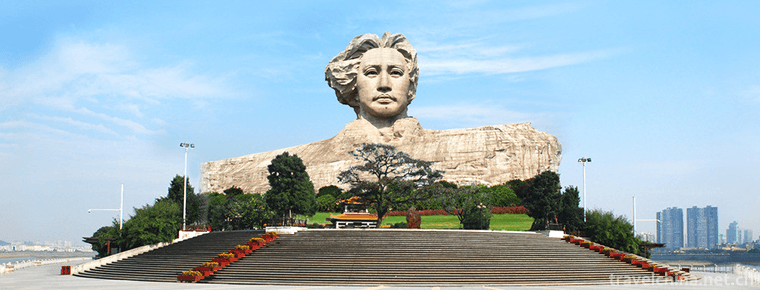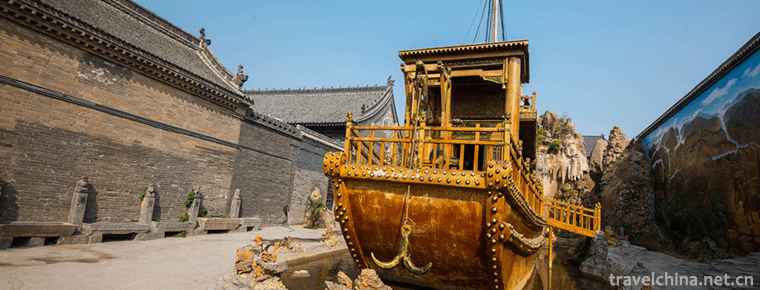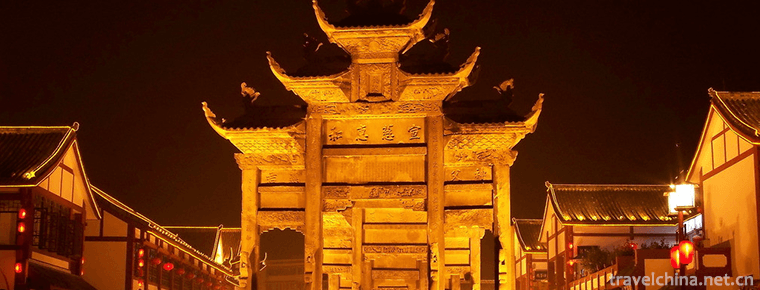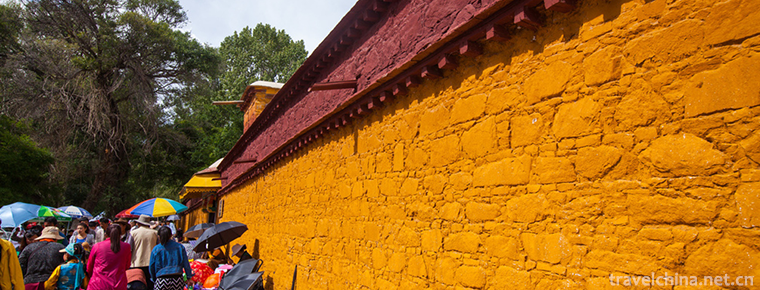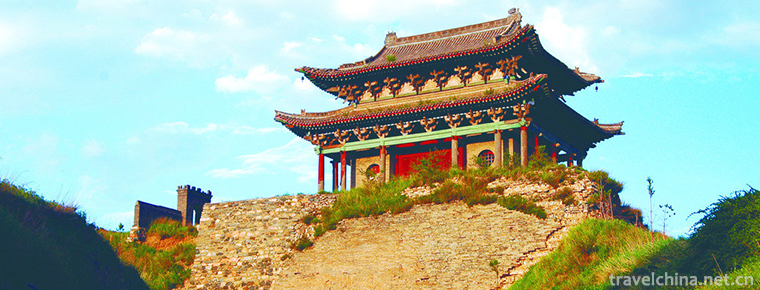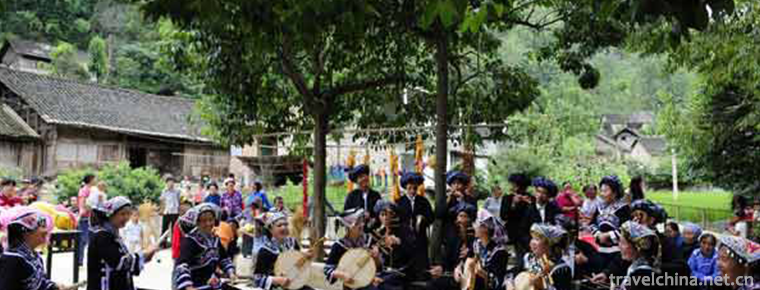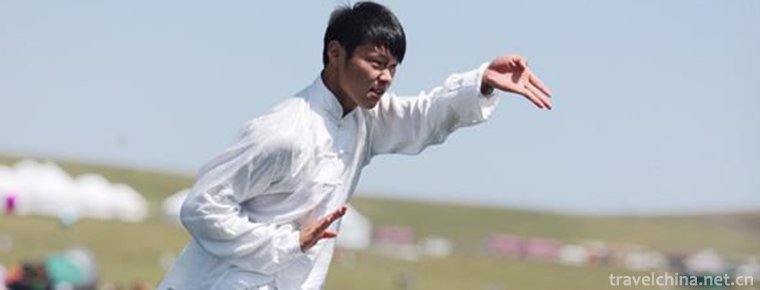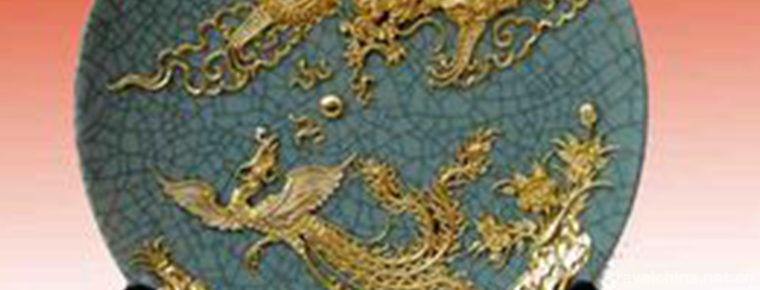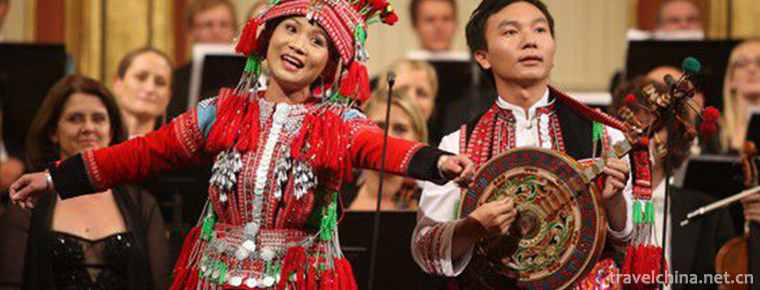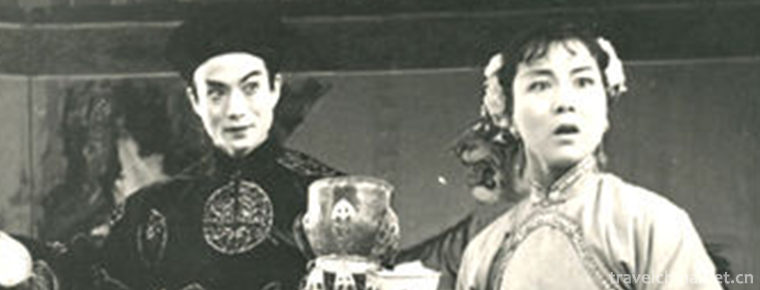Baoguang Temple
Baoguang Temple
Baoguang temple is located in Xindu District, Chengdu City, Sichuan Province, China. It is one of the Buddhist temples with a long history, large scale, complete structure and quiet environment. It is said that this temple was built in the Eastern Han Dynasty, but it is difficult to make a conclusion due to the lack of historical data. At the same time, there are temples named Baoguang temple in Tongzhou and Heilongjiang in Beijing. At the same time, Baoguang temple is one of the ten scenic spots in Chengdu.
brief introduction
Baoguang temple is located in the old city of Xindu District in the north of Chengdu. Starting from the downtown area of Chengdu, you can see a tall and ancient temple surrounded by red walls, pagodas and bamboo trees. This is the famous Baoguang temple in Xindu. Baoguang temple covers an area of more than 120
Mu, with a construction area of more than 20000 square meters, the temple is deep and secluded, ancient trees are verdant, and the five halls and sixteen courtyards are advancing step by step. It is one of the "four Buddhist forests" in southern China since the Qing Dynasty and a famous Buddhist temple in Sichuan.
Baoguang Temple
Baoguang Temple
It is said that Baoguang temple was built in the Eastern Han Dynasty, but there is no credible history to prove. In Sui Dynasty, it was named "Dashi Temple", and the pagoda in the temple was called "Fugan tower". In 880 ad, the Huangchao uprising army of the Tang Dynasty defeated Chang'an. The next year, Tang Xizong fled to Sichuan, built a palace in the temple, and ordered master Wuda to rebuild the temple. In the evening, when he saw the light from the pagoda in the temple, he changed the name of the temple to "Baoguang Temple".
However, from the perspective of the typical layout of the early Buddhist temples in China, I think the temple was built in the Sui Dynasty at the latest, and whether it was called Baoguang temple at that time could not be verified. However, according to the latest data of Shiyi Gongde stele unearthed in the temple in May 1996, it has been called Baoguang temple in 741, the 29th year of Emperor Xuanzong's reign. The pagoda in the temple is named Baoguang pagoda. Xindu of Sichuan Province is a pearl inlaid in the Chengdu Plain. It is 18 kilometers away from the urban area of Chengdu. It is one of the three capitals of ancient Shu state. Baoguang temple, located in Xindu County, is a cultural relic protection unit in Sichuan Province and one of the "four Buddhist jungles" in the south. It is recognized as a Buddhist temple with the longest history, the largest scale and the richest collection of cultural relics in Chengdu. It has more than one million visitors and pilgrims every year. Baoguang temple was first built in the Eastern Han Dynasty. After war, it was rebuilt several times, and finally became the current scale. It is said that Tang emperor Shizong fled to Sichuan because of the Huangchao uprising. He saw Xiangguang coming down from the Fugan Pagoda in the temple at night, and then dug out a stone box containing 13 sharia. Therefore, he changed the name of the temple to Baoguang temple, and placed the relic under the pagoda. The name of the pagoda was also called Baoguang pagoda. Baoguang tower is slightly inclined to the west, known as "Oriental Tower". It is said that in ancient times, the pagoda was crumbling. Buddhists risked their lives to protect the pagoda. They moved the emperor and sent four gods with the same height as the tower to support them around. One of them exerted too much force, and the tower tilted westward.
origin
It is said that Baoguang temple was built in the Eastern Han Dynasty. According to the record of the three treasures of Jishen xuanta Temple written by the quantitative lawyer of Zhongnan mountain road, it is recorded that in the Sui Dynasty, Yang Xiu, the king of Shu, dug the ground here and got a big stone. Zen master Zhishen then built a nine level forest tower on the stone. At that time, when there was drought or flood, officials and people prayed for rain this week, and there was a spiritual response. Therefore, the name of the temple was located in the stone, and the name of the tower was called "blessing". At the end of the Tang Dynasty, when Huang Chao uprising, he went to Shu and stayed in Jianxing palace. When he saw the sun shining out of the earth at night, he called on the eminent monks to know the mystery and ask the Dharma. Xuan said that there must be a sacrificial interest underground. The emperor ordered to dig it, and got a stone letter, which contained thirteen sharia, crystal clear. Then he ordered xuanjian to build the brick pagoda of 13 levels. He took the "no scale relic tower" and granted the temple the name of "Baoguang". Treasures in the temple: Baoguang Temple relic, bronze tripod, thousand Buddha stele, pottery tower, dragon and tiger bottle, bottle, parrot, five horse, Xu Beihong's galloping horse, etc.
Historical evolution
Tang dynasty
In 845, Emperor Wu Zong of Tang Dynasty ordered the demolition of more than 4600 big temples and 40000 small temples. Baoguang temple was doomed to disaster and Baoguang pagoda was also destroyed. In the first year of the Tang Dynasty (847), the Baoguang temple was restored, but the pagoda has not been rebuilt.
On the 5th day of December in the first year of Guangming of Tang Dynasty (i.e. January 8th of 881 AD), Huangchao uprising army broke down Chang'an, and Li Xuan, emperor of Tang Dynasty, fled to Shu under the protection of 500 Shence troops. In May of the first year of Zhonghe period (July 881), he passed through Xindu and once stayed in Baoguang temple. Later, he felt that the environment was very good and not far from Chengdu, so he built a palace behind the temple (the two pillars of the balcony of the palace are under the pillars in front of the seven Buddha Hall). Tang Xizong believed in Buddhism all his life. When he arrived in Chengdu, he immediately sent Guo zuntai with the emperor's "seal book" to welcome Zhixuan (i.e. Wuda National Master) who lived in seclusion in Jiulong Mountain of Pengzhou to accompany him.
On the eighth day of March, 883, the third year of the Tang Dynasty, he Zong had been lucky to Shu for nearly three years. It is said that on that night, he was sullen in the palace, and did not sleep at night, so he went for a walk in the temple. All of a sudden, he saw the rays shooting from the ruins of the pagoda, and he was panicked and asked what happened to master Wuda? Wu Da replied, "this is the light of the relic. It's a sign of auspiciousness. Now the Yellow nest is flat. Your majesty can go back to Chang'an.". He was overjoyed and asked to excavate. Sure enough, he found a stone letter in the pagoda palace. There were thirteen Buddhist relics in the letter, which were crystal clear and shining. Therefore, he ordered Wuda to rebuild the pagoda and expand the Buddhist temple. The pagoda is named wuscalingjingguang pagoda, and the Buddhist temple is still named Baoguang temple. At that time, there were more than 1000 monks in the temple, "the Buddhist temples in Sichuan are not prosperous here.". Therefore, master Wuda was respected as the founder of Baoguang temple in Tang Dynasty.
Song dynasty
In the Song Dynasty, the 11th generation founder of linjizong of Chinese Buddhism, foguokeqin (named Yuanwu Guoshi by Emperor Gaozong of Song Dynasty) opened the Dharma in Zhaojue temple in Chengdu. In the third year of Daguan period (1109), Baoguang temple was also held and the scale of the temple was expanded. According to the inscription "the end of the restoration of Baoguang Buddhist temple" on the tablet of Daoguang in the Qing Dynasty, "there are thousands of Zen masters in Song Yuanwu's practice.". The temple entered the peak of the Song Dynasty.
Yuan dynasty
In the Yuan Dynasty, temples were once dilapidated. In the early Ming Dynasty, Shi Zimei and others donated money to build Baoguang temple. In the 11th year of Yongle (1413), monk xinkong built the Zunsheng tuoroni mantra stone Scripture building in the temple. Later, the temple was destroyed in a fire. In the Zhengde period of the Ming Dynasty (1506 Zao 1521), the Baoguang temple was compiled by Yang Tinghe, the first assistant scholar of the dynasty, and the Hanlin academy, and the father and son of Yang Sheng'an, the number one scholar in Xindu City, donated to Baoguang temple.
Late Ming and early Qing Dynasty
Baoguang temple was destroyed in the war in the late Ming and early Qing Dynasty. In the ninth year of the reign of Emperor Kangxi of the Qing Dynasty (1670), monk Baoshan of shuangguitang in Liangshan County, Sichuan Province, sent his disciple, master Xiaozong Yinmi, to Baoguang temple. With the support of Bi Chengying, the magistrate of Xindu County, and the local gentry, he cut the thorns and revived the Taoist temple. He was known as the first generation of old monks in Baoguang temple in Qing Dynasty. During the more than 200 years from Kangxi to Guangxu, Baoguang temple, together with Wenshu temple, Zhaojue temple and Caotang temple in Chengdu, has sprung up as the "four Jinglan" near Chengdu. Along with Chengdu Wenshu courtyard, Jinshan Temple in Zhenjiang and Gaomin temple in Yangzhou, they are the "four jungles" in the Yangtze River Basin, i.e. "there are Manjusri and Baoguang in the upper part, Jinshan and Gaomin in the lower part".
the Republic of China era
During the period of the Republic of China, Baoguang temple has always maintained its lofty status as a Buddhist jungle. Among the "four Jinglan" in Chengdu, Baoguang temple is especially famous for its implementation of the rules of Zen sect. At that time, there was such a saying among the guashan monks: "to eat and drink, to Zhaojue; to go to the cottage; to close the pigs, to Wenshu; to sit incense, to Baoguang.". More than half of the monks in Emei Mountain were ordained in Baoguang temple. Therefore, Baoguang temple is known as "e Bantang". Many of the monks and nuns who took part in the study of Baoguang temple have made great achievements in their studies, and some of them have become well-known figures in the Buddhist circle of China.
After liberation
After liberation, Baoguang temple was protected by the people's government. In 1956, Baoguang temple was listed as a cultural relic protection unit in Sichuan Province. Especially in the "Cultural Revolution", many temples in China were damaged to varying degrees, but the temples, statues, plaques, paintings and other cultural relics of Baoguang temple were basically undamaged, and became the most typical and well protected Buddhist and Zen jungle in China. With the further implementation of the national reform and opening up policy, Baoguang temple, as a national key temple and famous tourist spot, will play an increasingly important role.
Architectural landscape
Overall structure
The building of Baoguang temple is made of wood and stone, with more than 400 stone columns. It is mainly composed of one tower, five halls and sixteen courtyards, surrounded by walls and surrounded by green trees. Along the central axis, there are four Buddhist temples, namely, Fuzi Zhaobi, Shanmen hall, Tianwang hall, stupa, Qifo hall, Tibetan Scripture tower, and Zixia mountain. On both sides are bell tower and Drum Tower. Guest hall, Yunshui hall, Zhaitang, Jietang, Luohan hall and Zen hall are symmetrical. Baoguang temple is the only early Buddhist temple in China with "one temple and tower in the center" The typical layout of the temple. The stupa in the temple, built in the Tang Dynasty, is a 30 meter high square brick Pagoda with dense eaves.
Structure of Luohan Hall
Luohan hall was built in the first year of Xianfeng in the Qing Dynasty (1851). There are 59 Buddhas, Bodhisattvas and patriarchs, and 518 Arhats, each of which is about 2 meters high. Among them, there are one statue of Kangxi and one statue of Qianlong. Beautiful shape, colorful painting, colorful, interesting. It is the longest and largest clay sculpture Luohan hall in China. There are many cultural relics in Baoguang temple, such as the Qianfo stele in 540, the sixth year of Datong of emperor Liang Wu of the Southern Dynasty; the Shiyi Gongde stele in 741; the Huayan Sutra in Yuan Dynasty; the Zunsheng tuoroni stone block in Yongle period of Ming Dynasty; the Tripitaka Sutra, jade Buddha and stone carving stupa in Qing Dynasty; the three treasures of zhensi Beiye Jing and tongyoutanhua, etc. There are 176 gold plaques, 24 inscriptions, 76 couplets on stone pillars, and more than 400 pieces of ancient handicrafts and celebrities' calligraphy and paintings are displayed in each hall, which sets off the historical and cultural atmosphere of Baoguang temple.
Luohan Hall of Baoguang temple is the longest and largest clay sculpture Luohan hall among the four existing arhat temples in China (the other three are located in Biyun temple in Beijing, Xiyuan temple in Suzhou and Guiyuan temple in Wuhan). It is famous for its wonderful statues. Every day, many Chinese and foreign tourists and Buddhists come to Luohan hall to visit, worship and explore the beauty.
Some people say that there are countless Arhats in Baoguang temple. Because of the unique structure of the arhat hall, the statues crisscross and the roads extend in all directions, just like a labyrinth. People who come to count the Arhats are often attracted by the grotesque statues. When they count, they see and count, and the results are always different. If you want to count the number of statues in Luohan hall, you must know its architectural structure.
Luohan hall is a square building with wooden and stone framework, with nine entrances and nine couplets, covering an area of 1600 square meters. Because there are four patios in it, its plane is in the shape of "field". In the center of Luohan hall, the roof rises in a dome. In the wide space, there stands a statue of Avalokitesvara, which is about six meters high, with 28 heads, 56 hands and 196 eyes. The other statues revolve around the word "Tian", with four layers inside and outside. The middle part is connected with the character "ten", which makes the passage twists and turns, and makes the atmosphere inside the hall more profound and unpredictable. However, the arrangement of the statues is very regular. It takes the peacock Ming king who enters the gate, the Guanyin Bodhisattva in the center, and the three body Buddha on the inner wall as the central axis. It is symmetrical from left to right, echoing back and forth, and coordinating inside and outside. Each layer and row has a fixed number.
How many statues are there in Luohan hall? According to the common custom, they are 500. However, after counting the "first arrowhead Bridge Chen ruzun" on the left side of the three body Buddha, from the outer layer to the inner layer, and all the way to the "500th person who wishes to serve all the people", there are still three Buddhas, six Bodhisattvas, eighteen Arhats and fifty patriarchs living on the "ten". So the total number of statues is 577.
Internal settings
Luohantang
Where did the five hundred Arhats in Luohan Hall of Baoguang Temple come from? It is said that there was a famous monk named Luo chenna in Qingshen County of Meizhou in the Tang Dynasty. His Taoist temple was located in Qingshen Zhongyan. Later, he took 500 disciples from Sichuan to Tiantai Mountain in Zhejiang Province. It is said that these 500 disciples are the five hundred Arhats who manifest themselves in the world. Therefore, the couplet of Luohan hall in Baoguang Temple says: "this is the Tiantai, like xianaro 500."
All kinds of interesting
The statues of luohantang are of various forms and interesting. First of all, it gives the impression that the form and expression are full of variety, and the posture and action are different. They are fat and thin, old and young, tall and short, beautiful and ugly His expression is either cheerful or sad, or kind and kind, or gentle and dignified, brave and brave, simple and funny, or cunning and sophisticated Some of them are sitting upright and holding their palms together; some are carefree and contented with their legs and knees; some are chatting and laughing with open mouth and arms; some are contemplative with their eyes closed and their cheeks closed Their actions are either holding objects or not holding objects, and the objects they hold are different: those holding magic instruments such as beads, wooden fish, precious pestles and Zen sticks; those holding utensils such as bowls, bowls, scrolls, crutches, dusts, etc.; those who play with bats, toads, cranes, unicorns, and others; those who hold glossy ganoderma lucidum, peach, Buddha's hand, pomegranate, etc At the same time, the styles, colors and patterns of their clothes are also different. All of these are skillfully combined with the character and environment of the characters, so that more than 500 statues have different shapes and purposes.
Many statues are created by means of romantic techniques through bold exaggeration and rich imagination. Among them, there are peacocks, dragon drivers, three heads, five eyes, glumes, and fetuses The three remarkable Arhats with long arms have their own special functions: the master with wonderful arms can catch birds, luohouluo can pick the sun, and the Dharma Master can catch the moon. These imaginative Buddhist myths and legends show the infinite wisdom of the ancient people and their good wishes to conquer nature, and also reveal the profound artistic attainments of the sculptors.
The characters are real and delicate
Luohantang statue, more is the use of realistic expression techniques, its lines bright and natural, accurate and beautiful shape, the image is real and delicate. The statue is slightly larger than the real person. In addition to the artistic exaggeration of some facial images, the head, trunk and limbs (except for the long armed arhat) are in line with the proportion of the human body. The clothing patterns, muscles and bones are also in line with the anatomical structure. It looks natural and appropriate and gives people a sense of beauty. Among the statues, there are 50 ancestors of all ages, especially the first ancestor of Zen Buddhism and the later ancestors of Bodhidharma in the northern and Southern Dynasties. They are not far away from home. Most of their looks and expressions are lifelike, and there is little sense of mystery in the Buddha statues. Some of the statues were made according to the portraits of their real faces before their death, and they kept their physiological defects without any taboo. For example, Zen master Miyun Dinghui of the Ming Dynasty (1565-1641), the thirtieth founder of the orthodox Linji sect of Zen Buddhism, had a clean face and white hair in his later years. However, his hair fell off due to the rash in the past and became bald. Therefore, there were only a few short and thin hairs on the top of his head, which matched the long and dense beard. Another example is Yuerong, the 37th founder of Linji orthodox Buddhism and the sixth abbot of Baoguang temple in the Qing Dynasty. He is short, puffy and has a small right eye. Due to the real shape of the characters, people are deeply impressed and the artistic effect of the statues is increased.
The five hundred arhat statues are quite different from those of Buddha and Bodhisattva. It is said that the Buddhist statues of various ethnic groups can not be found in the Buddhist practice of various ethnic groups. It is easy to see Indian people with dark skin and curly hair, people from western regions who are tall and broad-minded, and people with similar or similar faces to the Chinese people and people from Southeast Asia. In 1973, Han Suyin, a famous British woman writer, and her husband, Indian engineer Lu Wenxing, visited here. They pointed to several Arhats and said, "they really look like real Indians."
The statue of luohantang, with its rich and fragrant flavor, is drawn from the vivid images of real life, which reappears the character style of ancient society. Here are a few examples: bantuojia, one of the eighteen Arhats, was an Indian monk. He was playing with his beloved cub when suddenly the cub grabbed his left earring curiously and dragged it down. The compassionate Buddha held his beloved little spirit animal in his hands. His mouth was crooked with pain and his eyes were slanting. He buried his head and was at a loss. Seeing this situation, how can we not make people laugh!
Bodhi, the ninety eighth Dharma king among the five hundred Arhats, is bareheaded and barefoot, and is loose and lazy. He was half stripped of his robes, bare his shoulders, breasts and navel. His right elbow was resting on his right knee joint, and he was digging his ears. The expression of frowning, squinting and grinning showed his inner feelings of pain and comfort.
The 120th realm master is a Hu monk in the western regions with thick beard and beard. He was far away from the country. He lived alone. His clothes were broken and no one could do anything for him. So he had to sew and mend by himself.
The 207th boundless venerable is an old monk with wrinkled face and poor life. He took off his robe to his waist, revealing his thin ribs. He held a rake in his right hand (commonly known as "xiaoshunzi") and pinched his back with his back. At the moment, his facial expression was showing itching pleasure.
388 the SASA, who was a child loving elder, was open to his chest and smiling. Six children, who were really innocent, climbed their shoulders, stepped on their feet, or sat in their hands, even did the prank of digging his navel and pulling his ears. The elder was not angry and allowed them to play
The northern and southern sculptors show their magic power
The exquisite statues of luohantang are the products of the gathering of folk sculptors from the southern and Northern schools of China, working together and displaying their own powers. It can be said that it reached the peak of sculpture art at that time.
In the last years of Daoguang reign of the Qing Dynasty, master Miaosheng of Baoguang Temple employed three groups of sculptors: the Northern Shaanxi sect, the southern Sichuan western sect and the eastern Sichuan sect. The Luohan of Shaanxi bangsu has a big head, plump muscles and a peculiar shape. The styles of the two groups are similar. The head of the arhat is moderate and the expression is natural. It is different from the ordinary Bodhisattva statues, but more reflects the character of the characters in real life. Zhou, the leader of the Western Sichuan Gang, was skilled and honest. He devoted his whole life to shaping Bodhisattvas and teaching disciples. He had no child in his middle age.
Today, the old monk in the temple is also interested in telling the interesting legend that he finished the Luohan and got the noble son. What is worth mentioning here is Li Guangxiu of the East Sichuan gang. Guangxiu, formerly known as Desheng, is said to be a native of Hezhou (now Hechuan County, Chongqing). According to current research, he was born in Mianzhu County, Deyang City, Sichuan Province. When he was a child, he read poetry and later followed his father's generation to work on statues. Because he was smart and studious, he showed his skills in Baoguang temple and became a famous clay sculptor in Sichuan. When he was nearly 60 years old, at the request of the abbot of kunzhusi temple in Kunming and mengfo monk in Sichuan, he led five disciples to make five hundred Arhats, which lasted seven years. Li Guangxiu not only has accumulated rich experience in shaping arhat, but also is good at calligraphy and painting, and is proficient in poetry and Buddhism. Therefore, the statue is handy, unconventional and famous for its rich flavor of life.
There are more than 500 statues in Luohan Hall of Baoguang temple, which were created by three groups of sculptors. By observing their styles and comparing their advantages and disadvantages, we can still distinguish their works. But generally speaking, they all have their own advantages and achieve the same result. They are worthy of being one of the exquisite statues in Qing Dynasty and have been highly praised by later generations.
There are many cultural relics in Baoguang temple, including the "Thousand Buddha stele" carved by Emperor Wu of Liang Dynasty in 540; Zunsheng building built in 1413 of Yongle reign of Ming Dynasty; Beiye Scripture presented by the king of Thailand in 1906; and four shariks hidden in stone pagoda collected from Sri Lanka in the same year; and Tang Bohu, Zhu Zhishan, zhuchan monk, Zhang Daqian, etc Calligraphy and painting treasures of famous artists. On June 25, 2001, Baoguang temple, as an ancient building in Qing Dynasty, was approved by the State Council to be listed in the fifth batch of national key cultural relics protection units.
Mountain Gate
It was founded in the reign of Qianlong, with statues of Daodao God, Jingang Lishi and Yangting and Yang Shengan, county people of Ming Dynasty.
Tianwang Hall
In the fourth year of Jiaqing in Qing Dynasty (AD 1799), fodehe hall was built, and in the 10th year of Daoguang reign (1830 AD), the hall was built with Maitreya in the middle and four heavenly kings on both sides. The plaque of "first generation Zen" was hung on the eaves of the hall. The hall is also known as Zunsheng hall because of the stone inscription "Zunsheng tuoroni mantra" in the 11th year of Yongle reign of Ming Dynasty (1413 A.D.).
Stupa
It is located between the heavenly king hall and the seven Buddha Hall. In the Sui Dynasty, there were nine levels of wooden float and one hall. The pagoda was built in the Zhonghe period of Tang Dynasty. It has been broken and cultivated for more than 1000 years. Now it is a thirteen level four sided Pagoda with dense eaves. It is about 20 meters high and has three Buddha statues embedded on each side of each level. The bottom of the tower is covered with stone, and the statue of Sakyamuni is molded in the niche on the front of the bottom floor. It is a famous modern monk named Taixu. There are four bronze statues on each level. The tower is made of 140 statues of Buddha and 13 sharia made of copper, stone and jade. Tasha crown with gold and copper crown, shining sun, is one of the famous Buddhist relics. In history, it was called Baoguang temple, and Xiaozong Yinmi, a famous monk in the early Qing Dynasty, once wrote a poem to praise the pagoda, saying: the pagoda is sharp like a sword in the sky, and it has been fighting for many times in the Zhou and Tang Dynasties. In a peaceful world, I can't do anything but stay with my career as a pillar. "
Seven Buddha Hall
It is five rooms wide and four rooms deep. It has a single eaves and a rest mountain style. There are two relief dragon stone foundations under the eaves pillars in front of the hall. It is the only relic of the Tang Dynasty in the temple. Yang Sheng'an, the number one scholar in the Ming Dynasty, once wrote a poem on this basis: there was a terrace in the imperial palace of the Tang Dynasty, and the lotus flowers were changed into spring moss several times, and the military appearance went to Ye Shou again. Wang Qiyao came from Luogu. When the mountains and rivers are old and the cuckoo is sad at the fifth watch, they know that the road of Shu is not as good as Hu Seng's crossing the sea cup. In the hall, there are three niches on the Xumi pedestal, which are 50 cm high. There are seven Buddha statues for the world to celebrate. They are the bright Buddha, the multi treasure Buddha, the Baosheng Buddha, the wonderful color body Tathagata, the broad body Tathagata, the Liwei fear Tathagata, and the Amitabha Buddha. They are 4.4 meters and 3.1 meters high respectively. They are solemn and magnificent, and have high artistic value. In front of the shrine is a 1.36 meter white jade Reclining Buddha, which was donated by Burmese Buddhists in 1991. This hall was built in 1861, the 11th year of Xianfeng, Qing Dynasty.
Daxiong Hall
With an area of 700 square meters and a height of five Zhangs, it was first built by the emperor Xiaozong in Qing Dynasty, rebuilt by Huizhang monk in Qianlong period, and rebuilt by Miaosheng monk in Daoguang period. The whole hall is supported by 42 stone pillars, which is majestic. The temple is dedicated to Sakyamuni Buddha.
Pagoda of Baoguang Temple
On both sides, there are gayeh and Ananda venerable figures, and the sculpture craft is magnificent. "There is no fixed law in the world, and then you know the illegal law. When the world is over, why don't you let it go.".
Tibetan Scripture building
The largest hall in the temple, 17 meters high, 40 meters wide and 18 meters deep, is supported by stone pillars. It was built by Miaosheng monk during the reign of Emperor Daoguang in Qing Dynasty. There are 43 Dunhuang scriptures, 22 Fangshan stone scriptures, one northern Tibetan Scripture and one Pinjia Tibetan Scripture. There are 728 letters and 7280 volumes in total. In the hall is the statue of thousand handed Avalokitesvara. There are portraits of the sky on the four walls, which fully reflect the artistic style of the Qing Dynasty. The lower floor of the Tibetan Scripture building is the shuotang hall, which is the office of the abbots of all ages.
Chanting Buddha Hall
Located in the east side of the temple, it is behind the blissful hall from south to north. The hall is 10 meters high and nine couplets wide. It was printed and built in Tongzhi period of Qing Dynasty. There is a stone relic tower in the hall, which is about 5.5 meters high and 2 meters in diameter. It is carved out of three huge stones and is in the shape of a six square palace. The pagoda is finely carved with various figures, flowers, birds and animals centered on the story of Sakyamuni Buddha. The six stones are decorated with flying dragons, which are vividly shaped. It is said that it was carved by three famous workers in Qing Dynasty for three years. The abbots of all ages used it as the Pure Land Sect.
Notes on chanting
At the end of 1938, general Feng Yuxiang, who served as vice chairman of the Military Commission of the Kuomintang government, moved to Chongqing as the military and political center of the Kuomintang. He also traveled up the Yangtze River from Wuhan to Sichuan. In the eighth year of his stay in Sichuan, he made great efforts to stir up the national spirit and publicize the Anti Japanese and national salvation. He is not only a patriotic general, but also a patriotic poet.
On March 19, 1941, general Feng Yuxiang came to Xindu. After visiting the famous garden of Western Shu, Shengan Guihu Lake, he took the opportunity to visit Baoguang temple, an ancient Buddhist temple. He did not disturb the local officials of Xindu County, and the abbot and monk of Baoguang temple were absent. Zhike master had to go to the Western Abbot to invite the infinite old monk who had been retired for more than 20 years to accompany him in the eastern Abbot's guest hall. Seeing that he was an old man, general Feng asked wittily, "are you the old abbot of the temple? Why haven't you become a Buddha yet Infinity replied, "the old monk has committed a lot of crimes. It's still early to become a Buddha." Because of the fire in the East corridor of Baoguang temple in 1919, the old monk with profound Zen knowledge climbed to the top of the hall in a big red cassock and called for help. His voice was hoarse and he was very hard to speak. So he did not talk much and drank tea for a while, so he accompanied general Feng to the temples of the temple.
General Feng first went into shuotang and saw the "Jiufen Zen character" and the huge calligraphy and painting of "holding sand and offering Buddha" by bamboo Zen of "98 plus one old bhikkhu" on the left and right walls, then turned to the nianfo hall to watch the stone stupa with beautiful structure and gorgeous colors, then went to the blissful hall to see the white jade Buddha statue "coming to Burma and shining brilliance", and then went to Luohan hall to watch "each has its own splendor and magnificent view" ”Five hundred of arhat. After touring the palace, general Feng went around the curved red walls and the deep bamboo forest to watch the scenic spot of Zixia mountain in the back garden. There are many big nanmu trees on Zixia mountain, "the height is six or seven Zhang, the leaves are luxuriant and the root is solid; the tree head is the most special, each is not connected with the genus; this tree is clearly distinguished from that one." General Feng was deeply impressed by the architectural layout, Buddhist art and beautiful scenery of Baoguang temple. He wrote a poem and composition to narrate the process and experience of the tour.
General Feng wrote more than 1400 poems in his life. Because he was a soldier, he called these poems "Qiu Ba poems". In March 1938, Comrade Zhou Enlai invited general Feng to join the all China Anti enemy Association of literary and art circles as a "poet of Qiu Ba" and was elected as the director of the association. General Feng's poems are sincere, simple, easy to understand and bold, which reflects his patriotic and patriotic thoughts and military personality. At the beginning of his poem Baoguang temple, he wrote:
Baoguang temple, in Xindu, has a large temple and thick pillars.
The outline of Baoguang temple is outlined in 12 words. The temple covers an area of 90000 square meters, sharing more than 400 large stone pillars. The hall is magnificent and magnificent, and there are more than 500 arhat statues in Luohan hall. Arhat, according to the doctrine of Hinayana Buddhism, refers to the sage who has cut off all desires, freed himself from worries and is respected and worshipped. In the Luohan hall, however, the emperors Kangxi and Qianlong of Qing Dynasty were added to the ranks of Luohan.
As a fighter against feudalism and pioneer of democratic revolution, general Feng pointed out clearly in his poem: who was the emperor who appointed the arhat, and the emperor added it; the smell of feudalism was not changed, and there were many heroes in the revolutionary martyrs. From the revolutionary martyrs of Huanghuagang and the war of resistance against Japan in Lugouqiao, general Feng, with his poems full of patriotic passion of the Chinese nation, mobilized the monks to carry forward the fearless spirit to fight back the invasion of Japanese imperialism: monks should be fearless, the first to beat back the Japanese; I think monks should rise up, save the country and save people as the most urgent.
Driven by the climax of the Chinese nation's Anti Japanese and national salvation, and inspired by general Feng Yuxiang's Anti Japanese war poetry, the monks of Baoguang Temple rose up. They actively raised money for the Anti Japanese War, and some of them participated in the Sangha Anti Japanese propaganda team and rescue team.
Buddhist abbot
Yiji master, commonly known as Fu Shili, was born in September 1963 in Kaixian County, Chongqing. In September 1985, he became a monk in Baoguang temple, the capital of Xindu. He shaved under the seat of Minggao monk, the abbot of Baoguang temple and Baima temple in Luoyang. In September 1987, he was given the suzu commandment under the seat of Minggao monk. He graduated from Sichuan Buddhist College in 1990 and graduated from the Buddhist deacon training class in Sichuan Province in 2001. Since 1991, he has successively held the posts of Zhike, deputy temple, supervisor of Baoguang temple, member and deputy director of Baoguang temple, executive director of Chengdu Buddhist Association, executive director and Deputy Secretary General of Sichuan Buddhist Association, Deputy Secretary General of Chengdu Municipal People's Congress, and standing member of Chengdu Xindu District People's Congress.
Under the guidance of the 16th National Congress of the Communist Party of China, Yiji adheres to the road of adapting Buddhism to socialist society. He participated in the reception of Jiang Zemin and other party and state leaders at Baoguang temple in October 1999. In March 2003, he went to Thailand with the Chinese Buddhist delegation to meet the Buddha Tooth Relic and return home. In October of the same year, he went to Beijing to participate in activities commemorating the 50th anniversary of the founding of the Chinese Buddhist Association. He is patriotic and religious, and keeps pace with the times, which fully embodies the fine style of contemporary young Buddhists. Baoguang temple in Xindu is a famous Buddhist jungle in China, and there are many eminent monks.
In Baoguang temple, master Yiji received the cordial care and direct cultivation of the three great monks, Minggao, Quanneng and Zhenyi, and the Buddhist cultivation and Buddhism level were constantly improved. Since 1995, he has served as a guide to rites for many times in the preaching Dharma association inside and outside the province. In 1996 and 1997, he went abroad to attend Sino Japanese and Korean Buddhist cultural friendly exchanges. From 1998 to 2003, he successively participated in the "Sichuan religious forum" held by the Religious Bureau of Sichuan Province, and published many academic papers, such as "strengthening the self construction of young monks to meet the new century", "on the adaptation of Buddhism to socialism", "on the historical responsibility of Buddhist monks in the new century", etc. In March 2003, after the abbot of Baoguang temple and director of the Management Committee of monk Zhenyi passed away, master Yiji bravely took on the management responsibility of Baoguang temple, showing his extraordinary talent. He unites a group of people from the management committee and the majority of monks to earnestly study and implement the party's religious policies and theories in the new period, strengthen the construction of the belief, morality, education system, talents and organizations of Buddhist monks, do a good job in the temple facilities, cultural relics protection, landscaping, etc., and strive to show the Buddhist cultural characteristics of Baoguang temple, and give play to Baoguang temple as a window for the opening up of the new capital The role of. In recent years, the temple buildings have been comprehensively renovated, some famous trees and ancient trees have been rescued and protected, and hundreds of thousands of yuan of charity funds have been used for hope project, flood fighting and disaster relief and other social public welfare undertakings. Master Yiji, who was not confused for years, has been a deacon of Baoguang temple for a long time, and has accumulated rich experience in temple management. He was highly respected by all the monks in Baoguang Temple because of his pure style, serious work and strong working ability. He was elected as the 25th generation abbot of Baoguang temple in May 2004.
Traffic information
Public transportation:
1. Take bus no.651 from wukuashi to Baoguang temple in Chengdu.
2. Take bus no.650-660 in the urban area of Chengdu to Xindu District, and transfer to bus X05, X08, X10, x41, x44, x45, x47 and k8a.
Self driving:
1. Drive 10.6 km along the Chengdu North Exit expressway, enter the Chengdu Chongqing Ring Expressway, drive 5.7 km, drive from Xindu exit to Xindu Avenue, and drive to the middle section of Baoguang Avenue.
2. Go northward along Chuanshan road No.1, turn left at Xindu Ring Road junction, and then turn left at the intersection of Baoguang avenue after 100 meters.

-
Inner Mongolia Autonomous Region Alshan Chaihe Tourist Scenic Area
Inner Mongolia Autonomous Region Alshan Chaihe Tourist Scenic Area/Chaihe Tourist Scenic Spot has a total area of 1368.7 square kilometers.
Views: 167 Time 2018-12-02 -
Yuelu Mountain and Orange Prefecture Tourist Area
Orange Island Scenic Area is located in the heart of the Xiangjiang River opposite Changsha City, Hunan Province. It is the largest famous island in the Xiangjiang River with an area of 91.4 hectares.
Views: 184 Time 2018-12-12 -
kangbaiwan manor
Kang Million Manor, also known as Heluo Kangjia, is located in Kangdian Town, Gongyi City, Henan Province (formerly Gongxian County). It was built in the late Ming and early Qing Dynasties.
Views: 192 Time 2019-01-29 -
Longchang Shipaifang Tourist Area
Located in Longchang City, Sichuan Province, China, Longchang Stone Memorial Architecture is a very important type of traditional Chinese architecture. It was rated as a class 4A tourist attraction by.
Views: 171 Time 2019-02-06 -
Luo Bu Lin Ka Roblinka
Roblinka is a national key cultural relic protection unit, located in the western suburbs of Lhasa, Tibet. Founded in the 1840s (Dalai VII), the Dalai Lama's summer administration place is a typical T.
Views: 186 Time 2019-02-06 -
Yanmenguan Scenic Area
Yanmenguan Scenic Spot is located in the northern part of Daizhou ancient city. South-controlled Central Plains and North-controlled Moyuan are grand military defense projects of ancient Chinese passe.
Views: 106 Time 2019-03-01 -
Buyi Eight tone Sitting Singing
Buyi eight-tone sitting-singing, also known as "Buyi eight-tone", is a form of folk music and singing handed down from generation to generation by the Buyi people.
Views: 109 Time 2019-04-04 -
Jia Jia Quan
Amaranth, also known as Amaranth, Amaranth hammer, one of the traditional Chinese boxing. It was founded by Mr. Junai Zhou (1724-1783) in Heshui County, Zhengzhou, in the reign of Qianlong in the Qing.
Views: 224 Time 2019-04-16 -
Xiamen lacquer line carving skills
Xiamen lacquer line carving technique is to use old brick powder, large paint and cooked tung oil as raw materials to mix, repeatedly beat into soft and resilient clay (commonly known as "lacquer.
Views: 84 Time 2019-06-12 -
The seafood tune of the Yi nationality
The seafood tune of the Yi nationality Shiping Yi seafood tune, also known as "Shiping tune" and "Quzi", is commonly known as "inverted paddle". It is named after a herba.
Views: 316 Time 2019-07-12 -
Ningbo Opera
Yong Opera is a local opera sung in Ningbo dialect of Zhejiang Province. Its musical tone belongs to Tanhuang. After 1938, this opera genre was officially called "Yongju" or "improved Y.
Views: 182 Time 2019-07-14 -
Shicheng mountain
It is located in Shicheng mountain, Hengjiang Town, Xuzhou District, Sichuan Province. The total area is 5500 mu, including 4100 mu of forest. Shicheng mountain inclines from southwest to northeast. It has a good momentum.
Views: 133 Time 2020-10-16

